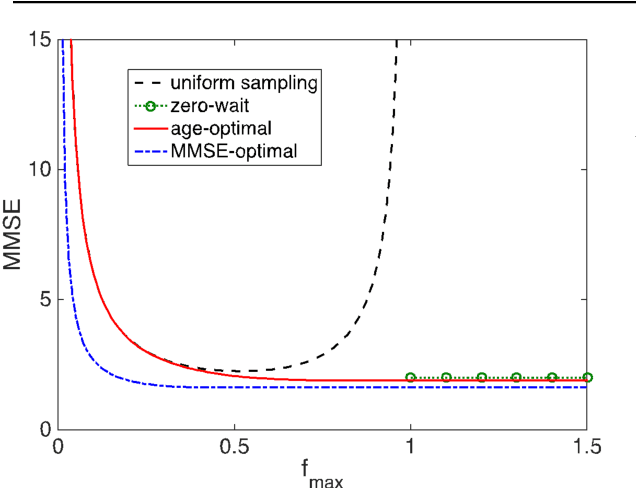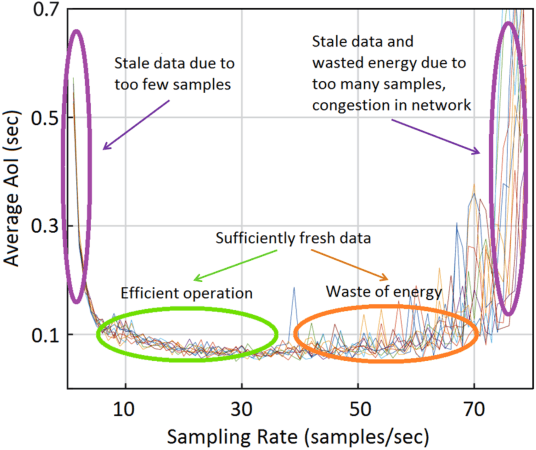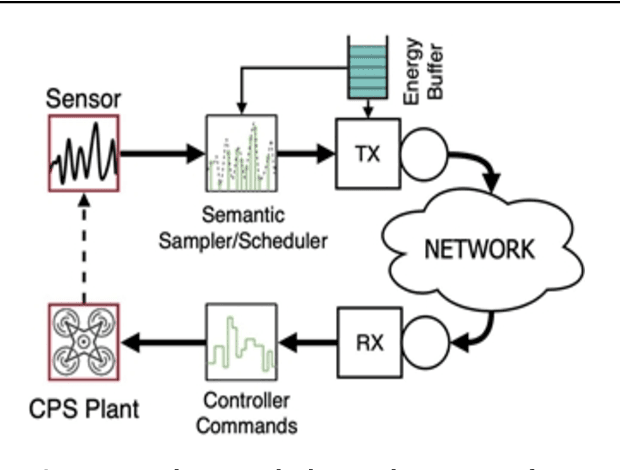Anthony Ephremides
Age of Actuation and Timeliness: Semantics in a Wireless Power Transfer System
Dec 21, 2023Abstract:In this paper, we investigate a model relevant to semantics-aware goal-oriented communications, and we propose a new metric that incorporates the utilization of information in addition to its timelines. Specifically, we consider the transmission of observations from an external process to a battery-powered receiver through status updates. These updates inform the receiver about the process status and enable actuation if sufficient energy is available to achieve a goal. We focus on a wireless power transfer (WPT) model, where the receiver receives energy from a dedicated power transmitter and occasionally from the data transmitter when they share a common channel. We analyze the Age of Information (AoI) and propose a new metric, the \textit{Age of Actuation (AoA), which is relevant when the receiver utilizes the status updates to perform actions in a timely manner}. We provide analytical characterizations of the average AoA and the violation probability of the AoA, demonstrating that AoA generalizes AoI. Moreover, we introduce and analytically characterize the \textit{Probability of Missing Actuation (PoMA)}; this metric becomes relevant also \textit{to quantify the incurred cost of a missed action}. We formulate unconstrained and constrained optimization problems for all the metrics and present numerical evaluations of our analytical results. This proposed set of metrics goes beyond the traditional timeliness metrics since the synergy of different flows is now considered.
To Re-transmit or Not to Re-transmit for Freshness
May 17, 2023Abstract:We consider a time slotted communication network with a base station (BS) and a user. At each time slot a fresh update packet arrives at the BS with probability $p>0$. When the BS transmits an update packet for the first time, it goes through with a success probability of $q_1$. In all subsequent re-transmissions, the packet goes through with a success probability of $q_2$ where $q_2>q_1$, due to the accumulation of observations at the receiver used to decode the packet. When the packet goes through the first time, the age of the user drops to 1, while when the packet goes through in subsequent transmissions, the age of the user drops to the age of the packet since its generation. Thus, when the BS is in the process of re-transmitting an old packet, if it receives a new packet, it has to decide whether to re-transmit the old packet with higher probability of successful transmission but resulting in higher age, or to transmit the new packet which will result in a lower age upon successful reception but this will happen with lower probability. In this paper, we provide an optimal algorithm to solve this problem.
Minimizing the Age of Information Over an Erasure Channel for Random Packet Arrivals With a Storage Option at the Transmitter
Jan 10, 2023Abstract:We consider a time slotted communication system consisting of a base station (BS) and a user. At each time slot an update packet arrives at the BS with probability $p$, and the BS successfully transmits the update packet with probability $q$ over an erasure channel. We assume that the BS has a unit size buffer where it can store an update packet upon paying a storage cost $c$. There is a trade-off between the age of information and the storage cost. We formulate this trade-off as a Markov decision process and find an optimal switching type storage policy.
Age of Information of a Power Constrained Scheduler in the Presence of a Power Constrained Adversary
Jan 03, 2023Abstract:We consider a time slotted communication network consisting of a base station (BS), an adversary, $N$ users and $N_s$ communication channels. Both the BS and the adversary have average power constraints and the probability of successful transmission of an update packet depends on the transmission power of the BS and the blocking power of the adversary. We provide a universal lower bound for the average age for this communication network. We prove that the uniform scheduling algorithm with any feasible transmission power choosing policy is $4$ optimal; and the max-age user choosing policy is $2$ optimal. In the second part of the paper, we consider the setting where the BS chooses a transmission policy and the adversary chooses a blocking policy from the set of randomized stationary policies. We show that the Nash equilibrium point may or may not exist for this communication network. We find special cases where the Nash equilibrium always exists.
Semantic Communications in Networked Systems
Mar 09, 2021



Abstract:We present our vision for a departure from the established way of architecting and assessing communication networks, by incorporating the semantics of information for communications and control in networked systems. We define semantics of information, not as the meaning of the messages, but as their significance, possibly within a real time constraint, relative to the purpose of the data exchange. We argue that research efforts must focus on laying the theoretical foundations of a redesign of the entire process of information generation, transmission and usage in unison by developing: advanced semantic metrics for communications and control systems; an optimal sampling theory combining signal sparsity and semantics, for real-time prediction, reconstruction and control under communication constraints and delays; semantic compressed sensing techniques for decision making and inference directly in the compressed domain; semantic-aware data generation, channel coding, feedback, multiple and random access schemes that reduce the volume of data and the energy consumption, increasing the number of supportable devices.
 Add to Chrome
Add to Chrome Add to Firefox
Add to Firefox Add to Edge
Add to Edge